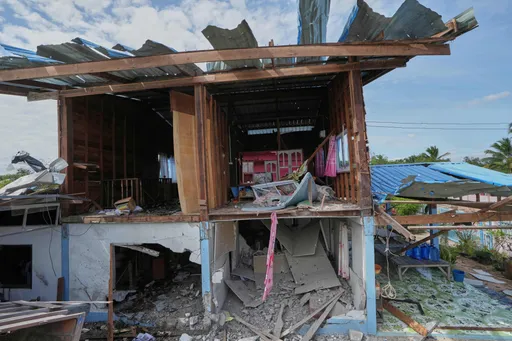Embroiled in various conflicts, the Middle East has become a battleground where different war machines and weapons have been deployed by different states, but in the past few years something unprecedented has happened.
Missile technology is no longer out of bounds for non-state actors. Different armed groups have unbridled access to different kinds of missiles, changing the nature of warfare.
“Missiles have become an equaliser in many asymmetric conflicts in the region as non-state actors no longer just rely on unconventional warfare tactics when engaging state opponents who traditionally had a technological superiority,” says Andreas Krieg, a senior lecturer at the School of Security Studies at King's College London and Royal College of Defence Studies, and fellow at the Institute of Middle Eastern Studies.
According to recent studies, more than 5,000 sophisticated missiles have been fired in armed engagements since World World II and more than 90 percent of them have been used in the Middle East. The US accounts for nearly 2,000 missile attacks in the region, during its two invasions of Iraq and other operations across the Middle East.
“Everyone knows that drones and ballistic missile usage by state and non-states have changed the character of warfare,” says Khalil Dewan, a researcher and an analyst on drone warfare and armed conflicts.
A missile should not be misconstrued as a rocket. In military lingo, a missile is a guided weapon with a long-range which can be fired from both static or mobile launch pads. Unlike rockets, missiles can penetrate deep into the enemy territory and cause serious damage to humans and infrastructure.
In the past few years, the Houthi rebel group in Yemen has gained easy access to missile technology and the armed group has used it against states like the UAE and Saudi Arabia. On the other hand, the Hamas' armed wing, Qassam Brigades in Palestine has heavily relied on rockets during wars and skirmishes with the Israeli forces.
But how do non-state actors procure such weapons?
Iran, a Shia-majority country, which uses many proxies from Iraq to Syria, Lebanon and Yemen across the Middle East, plays a central role in supplying missiles and sophisticated rocket technology to various armed groups in the Middle East. It not only provides these groups with technological devices but also trains them to build homegrown missiles.
“Especially Iranian missile technology has been widely procured in the region to close the technological gap between state and non-state actors. Equally important has been drone technology, which has become a lot cheaper and has become the new AK 47 of insurgency and terrorist groups,” Krieg tells TRT World.
The Houthis, fighting against a Saudi-led coalition in the Yemen civil war, and Hamas, which fights against Israel, have employed both Iranian-made missiles and the country’s rocket technology to produce homegrown missiles and rockets.
“Drone and missile technology allows non-state actors to bypass conventional defences and hit states deep inside their territories increasing the strategic costs and burden on state actors who might have operated with impunity in the past,” says Krieg.
“In the context of Palestine and Yemen, non-state actors have surprised their opponents as of late with both quantity and quality of new ballistic technology available,” he adds.
In recent years, the use of missiles has been even more common from the Gulf to Syria and Palestine. In the last three weeks, the Houthis on several occasions have sent ballistic missiles targeting the UAE's territories, including its capital Abu Dhabi and its commercial centre Dubai.
“Both Hamas and the Houthis are able to hurt their opponents and bring the war deep into their territory, forcing conventionally believed superior enemies to make concessions. While low intensity insurgency might be sustainable for some state actors, ballistic missiles and drones create high impact strikes that are unsustainable for state actors in the long run,” sees Kreig.
Houthis against the Emirates and Saudis
Since 2014, Yemen has been through a brutal civil war in which the Shia group Houthis fight against the Saudi-backed coalition, which includes the UAE. The civil war has also triggered the world’s worst humanitarian crisis.
While the Saudi-led coalition has launched deadly airstrikes against Houthi-controlled areas, the Shia group has also used its drones and ballistic missiles, targeting both Saudi and UAE territories.
“Recent activity by the Iranian-backed Houthis against Abu Dhabi serves as an example of how domestically improvised drones can influence geo-political negotiations and conflict dynamics at a low threshold of violence,” Dewan tells TRT World.
The Houthis have recently targeted the UAE because Abu Dhabi has increased its military involvement in the Yemen conflict, supporting its allies to defeat the rebel group in the critical oil-rich regions, especially Marib and Shabwa, experts say.
“The Houthis want the UAE to return to its policy of non-confrontation, and are firing missiles to pressure Abu Dhabi into doing so,” said Sami Hamdi, a Middle Eastern political analyst and head of the International Interest, a political risk group, in a previous TRT World interview.
The first Houthi attack on the Abu Dhabi airport killed three foreign workers while the second attack caused no casualties, according to Emirati sources. The third attack happened this week during the Israeli President Isaac Herzog’s visit to the UAE, something which is a first between the two countries.
After the Houthi attacks, the UAE-backed Giants Brigades, a Yemeni force, announced last week that they will end their military offensive in Houthi-held areas around Shabwa and Marib, according to Mohammed al Qadhi, a Yemeni expert. “This coincides with a halt of the coalition airstrikes on Sana’a and other provinces,” he wrote on Twitter.
The Houthi attacks also appeared to aim to scare away the oil-rich UAE’s commercial network, which includes many foreign investors.
Prior to their targeting of the UAE, the Houthis have also sent many missiles into Saudi Arabia, aiming at the country’s biggest oil production centres, which resulted in interruptions in global oil supplies for some time.
How states react
This week Israel also sent missiles into Syrian territory, targeting Iran-backed Hezbollah positions near the country’s capital Damascus. Tel Aviv has targeted Syria several times before, allegedly hitting Iran-backed Shia militias' supply lines and weapons depots. Iran backs the Assad regime with the help of its Shia proxy forces in Syria.
But states go beyond even using missile technology to go after their enemies and rival armed groups, developing better communication and collaboration among themselves to either defeat or keep them in check. They are using the most advanced technology to sharpen their fighting skills against non-state actors.
“The real game changer is network-centric warfare, where states collaborate on signal intelligence, share target data and enjoy multi-strike capability in conflicts across the MENA they’re not even involved in,” Dewan says.
“This is the level of sophistication that the changing character of warfare is really at - which is subject to upgrade with artificial intelligence and autonomous beings,” he says.
“While newbies to drone warfare focus on the optics, machinery and the sales - others are instrumentalising ‘air supremacy’ and ‘air policing’ in the shadows.”
























